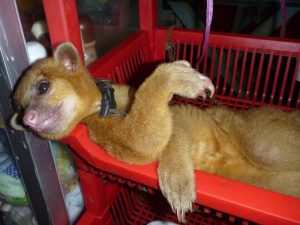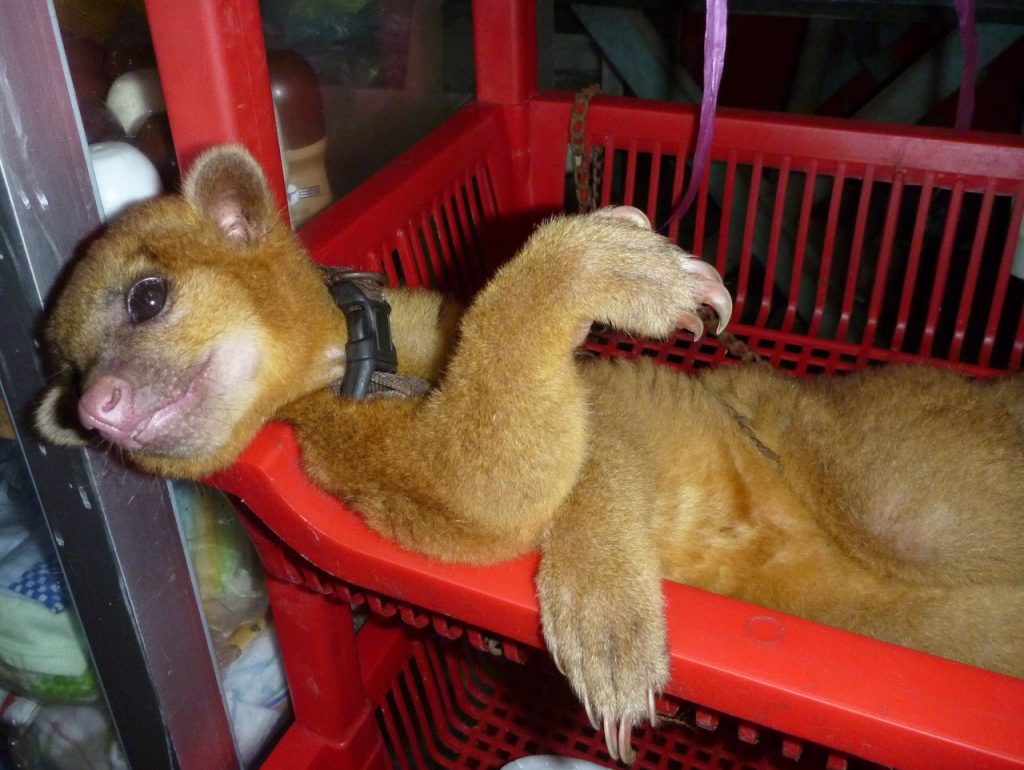Kinkajous (Potos flavus) are members of the Procyonidae family, whose natural habitat is the tropical forests of South and Central America.
Unlike some of their other relatives, kinkajous have long tails, which can curl around branches in much the same way as a hand can. Their closest relatives are:
- Red pandas
- Olingos
- Civets
- Cacomistles
- Raccoons
What Is a Kinkajou?
A common nickname is honey bear because they like honey and their fur is golden like honey. However, they are also referred to as “night walkers” because they are the most active around 7 to 12 pm. (So, unless you are a night owl yourself, they might not be the best pet for you.)
The kinkajou is a nocturnal animal, and in the wild, it is hard to see because it lives in tree canopies. As they are vocal animals, it is easier to hear them than to see them. They are frugivorous (fruit-eating) mammals but unlike their relative the raccoon, they feed from trees rather than the ground.
They are excellent climbers that can hang upside down with ease. They use their prehensile tails just like monkeys do to help them scramble around branches. In fact, they are sometimes mistaken for monkeys, but they are not members of the primate family.

Kinkajous are captured for their fur as well as for the commercial pet trade. Many traders use their fur for making saddles and wallets. However, despite being hunted for trade purposes, they are not viewed as an endangered species. Traders who sell them as pets do not seem to be affecting their population.
Kinkajous as Pets?
Most kinkajous sold as exotic pets will never be domesticated and cannot be regarded as true pets. This is because it takes many generations of selective breeding to domesticate a wild animal.
They are known to be friendly as well as affectionate pets although they might, at times, not be completely trustworthy. They may bite or claw their owners when they are excited or startled.
They are adorable when young but become aggressive as they grow up, and some may need to be neutered to prevent these injurious tendencies. Also, an wild animal may be the carrier of zoonotic diseases, so you could be putting yourself or your family at risk.
Finally, a kinkajou is expensive and might cost $1,500 to $3,000.
Diet and Feeding
While they will eat leaves and nectar from flowers, kinkajous prefer fruit. In their habitat, they feed in fruit patches. As mentioned earlier, they are sometimes mistaken for members of the primate family.
Oddly enough, their preferred diet is similar to that of a spider monkey.
Kinkajou Traits and Characteristics
In their habitat, Kinkajous are arboreal (tree-dwelling) but as pets, they play and live primarily at ground level. They are most active and playful during the evening up to early dawn.
It is tough, if not impossible, to train these animals to use a litter pan. They do, however, have specific spots from which they defecate and urinate.
This is typically from a high perch. These places should be found, and protective material placed below the perches to make clean up easier.
Housing a Kinkajou as Pets
A kinkajou needs a large cage, so it can sleep peacefully during the day, since it is a nocturnal animal. It should be easy to clean and large enough to allow your furry friend to move around freely and get enough exercise.
In fact, the cage should have enrichment items like branches, toys, and ledges to ensure your pet is comfortable and does not get bored.

If you plan to let your pet visit other rooms in the house, you may need to “childproof” the rooms and supply some protective coverings for furniture and floors. While we are on this topic, you do need to plan for your pet to have time out of the cage.
Confining it to a cage, which is an unnatural environment for it, could stress it. Animals that are stressed, just like humans that are stressed, can become sick or even die.
You will also need a carrying crate, which is useful for transporting it to the vet for examinations and treatments.
Kinkajous can also be trained to walk on a harness or leash and taken outside for walks. Just make sure the harness is secure to prevent an escape attempt by your pet.
Breeding and Ownership
Breeding a Kinkajou is not easy because it needs a lot of attention to make it stay healthy, safe, and happy. There are different legislations about the ownership of a Kinkajou, which depend on the area of jurisdiction.
In some places, it is illegal to own one but in others, you might need to have a legal permit.
Health Risks and Considerations
Some kinkajous carry a bacterium (Kingella potus) in their saliva. This causes severe gastrointestinal discomfort like headaches and fever, which require medical attention. Also, kinkajou feces could contains the same roundworm eggs as those commonly found in raccoons.
Human infection caused by this roundworm cause serious neurological symptoms and may even be fatal. Because of these health risks, you should have your kinkajou evaluated for parasites or infectious diseases before bringing it home.
It’s important to dispose of the animal’s feces regularly. Clean areas where the feces collect with boiling or steaming water to destroy the roundworm eggs and wash your hands thoroughly after touching the pet. The animal’s feces and cage should be checked regularly by the vet and deworming treatment done when necessary.
The Final Word
Kinkajous gained popularity as pets due to their ownership by celebrities such as Paris Hilton. However, just because a celebrity owns an exotic pet doesn’t mean it is a good pet for your family.
Considering factors such as cost, lifetime health care and feeding, and possible human risk can help you make a good decision.

If you decide after making a purchase that a kinkajou is not a good fit with your family, you can’t just drop it off at your local animal shelter.
Re-homing an exotic pet can be time consuming and expensive.
If you are unprepared or unable to properly care for your pet, you are putting it as well as your family at risk. Are you sure a kinkajou is the right pet for you?

